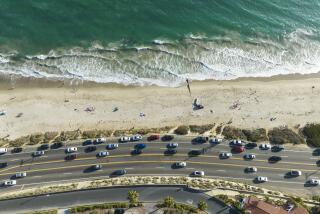Last Newport Beaches Get the All-Clear
- Share via
NEWPORT BEACH — A popular three-mile stretch of shoreline in this famed seaside city was declared safe and ready for reopening today after laboratory tests showed no remaining health threat from the Alaskan crude that washed ashore after last month’s 394,000-gallon oil spill.
Beaches had been closed from the Santa Ana River mouth south to the Newport Pier since the Feb. 7 spill. But health officials announced Friday that tests of dozens of sand samples for potentially harmful hydrocarbon residues were well below 100 parts per million, which is the level deemed acceptable by state and federal experts.
“The beaches were given a thorough inspection by a joint audit team,” Newport Beach Fire Capt. Ray Pendleton said, “and we didn’t see any oil, feel any oil in the sand or smell any oil. The tests confirmed that. All city beaches are now open.”
That leaves just 1 1/2 miles of shoreline in Huntington Beach still closed to the public after the 811-foot tanker American Trader punctured its forward hull on its own anchor, causing the spill.
A mile of Huntington State Beach between the Santa Ana River and Magnolia Street was cleared for opening Friday by health officials. But that beach will not be reopened until probably Monday, a spokesman for British Petroleum said, because the company, which owned the oil that was spilled, is using that area to stage its cleanup operations.
Another half-mile of beach near the Huntington bluffs north of Golden West Street will also remain closed until next week because of continuing work on oil-coated rocks.
A team of local, state and federal officials said Friday that the jetties separating the Santa Ana River from two storm channels, including one leading to a newly restored saltwater marsh, are clean. In recent weeks, mop-up efforts have concentrated on the troublesome jetties, where the thick crude coated rocks and collected between the boulders.
High tides and big waves two weeks ago carried an oily residue from the rocks up the Talbert Channel into the Huntington Beach wetlands, an ecologically sensitive nesting area for migratory birds. The presence of oil in the marshy reserve alarmed environmentalists and local officials and prompted British Petroleum to redouble rock-scrubbing efforts along the river jetties.
BP, which is coordinating the mop-up for the owners of American Trader, dispatched fewer than 80 workers Friday to clean up along the coast, and more workers are expected to be released over the weekend.
“The job is winding down quickly,” said Tony Kozlowski, a company spokesman.
The task of wooing tourists back to the county coast will get a big boost from BP, which has agreed to pay more than $140,000 to place two full-page color ads in USA Today, a national newspaper. Chuck Webster, a BP spokesman, said an agreement to underwrite the ads was worked out late Thursday with tourism officials in Huntington Beach and Newport Beach, the two cities where the shoreline was most seriously polluted.
“We have agreed to run a pair of ads the last week of March and first week of April to let everybody around the country know that the oil is gone and the beaches are ready for visitors,” Webster said. “Merchants had expressed concern that Easter business could be hurt, unless we get the word out that everything is back to normal.”
In the view of fire Capt. Pendleton, conditions on Newport beaches are better than normal.
“I’ve been here for 25 years, and I’ve never seen the beaches look this good,” Pendleton said. “In the past, getting a little tar on your feet was natural. But I don’t think there’s any tar out there now.”
For the stretch of beach between the river jetties and the Newport Pier, the average hydrocarbon level in sand samples that were tested was 27 parts per million, well below the accepted standard of 100 parts per million, Pendleton said. The single highest reading among the four dozen samples tested was 75 parts per million, he said.
More to Read
Sign up for Essential California
The most important California stories and recommendations in your inbox every morning.
You may occasionally receive promotional content from the Los Angeles Times.













